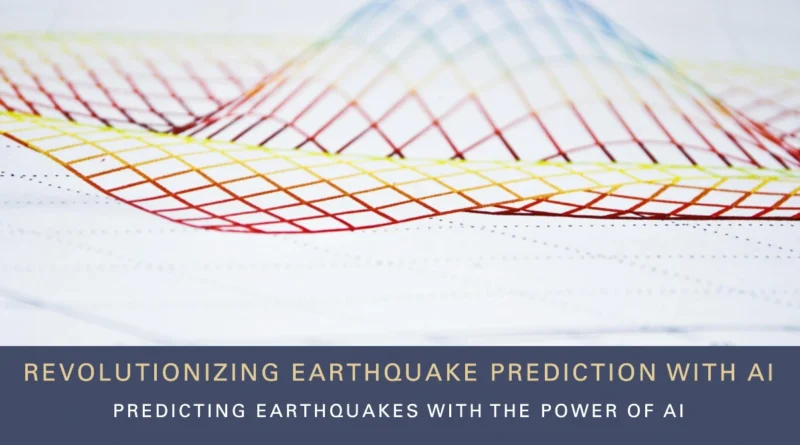Harnessing Artificial Intelligence for Earthquake Prediction
In a world where natural disasters can strike with devastating force and little warning, the development of accurate earthquake prediction systems is of paramount importance. The year 2023 has witnessed remarkable advancements in this field, as scientists and researchers harness the power of artificial intelligence (AI) to predict earthquakes. In this blog, we will delve into the exciting progress made in earthquake prediction through AI, exploring its potential impact on disaster preparedness and response efforts.
The AI Revolution in Earthquake Prediction
AI-Driven Earthquake Forecasting
One of the most promising breakthroughs in earthquake prediction comes from researchers at The University of Texas at Austin. They have developed an AI algorithm that boasts an impressive 70% accuracy rate in predicting earthquakes a week in advance during trials [^3^]. This significant accuracy level opens up new possibilities in the realm of earthquake forecasting, which has historically been fraught with challenges.
The Significance of AI Accuracy
Why is this level of AI accuracy such a game-changer in earthquake prediction? To understand this, let’s delve deeper into the implications:
1. Early Warning Systems
AI-driven earthquake prediction offers the potential to create more robust early warning systems. With a 70% accuracy rate, authorities and communities can receive alerts ahead of time, enabling them to take proactive measures to mitigate damage and protect lives.
2. Improved Disaster Preparedness
Accurate earthquake predictions empower emergency services and communities to be better prepared. They can allocate resources, plan evacuations, and reinforce critical infrastructure in advance, reducing the overall impact of seismic events.
3. Minimizing Losses
Perhaps the most significant impact is on human lives and property. With AI-aided predictions, there’s a greater chance of minimizing casualties and property damage by taking timely actions.
How AI Makes Earthquake Prediction Possible
Understanding how AI achieves these remarkable predictions is essential. Here’s a simplified overview of the process:
Data Collection
AI systems gather vast amounts of data from various sources, including seismographs, satellites, and historical earthquake records. This data provides valuable insights into seismic activity.
Machine Learning
Machine learning algorithms process and analyze the data, identifying patterns, anomalies, and precursors to earthquakes. Over time, these algorithms become more accurate as they refine their predictions.
Real-Time Monitoring
AI continuously monitors seismic data in real-time, allowing it to detect subtle changes that may indicate an impending earthquake. This real-time aspect is crucial for early warning systems.
Predictive Models
Based on the analyzed data, AI generates predictive models that estimate the likelihood and location of future earthquakes. These models are constantly updated as new data becomes available.
The Impact on Disaster Preparedness
Accurate earthquake prediction through AI has a profound impact on disaster preparedness efforts:
Impact on Disaster Preparedness
| Aspect | Impact |
| Resource Allocation | Authorities can allocate resources effectively. |
| Evacuation Planning | Communities can plan and execute evacuations. |
| Infrastructure Safety | Critical infrastructure can be reinforced. |
These preparedness measures collectively enhance a community’s resilience against earthquakes, ensuring that they are better equipped to face this natural phenomenon.
AI’s Role in Minimizing Losses
The ultimate goal of earthquake prediction is to minimize losses. AI plays a vital role in achieving this objective:
Minimizing Losses
| Objective | How AI Helps |
| Saving Lives | Early warnings enable timely evacuations. |
| Property Protection | Measures can be taken to safeguard buildings. |
| Infrastructure Resilience | Critical infrastructure can be reinforced. |
Through accurate predictions, AI contributes significantly to reducing the human and economic toll of earthquakes.
Challenges and Future Directions
While AI has made substantial progress in earthquake prediction, challenges remain. These include refining algorithms, expanding data sources, and ensuring widespread access to early warning systems. The road ahead involves collaboration between scientists, governments, and technology experts to overcome these hurdles.
Challenges and Future Directions
| Challenge | Future Directions |
| Algorithm Refinement | Continuous improvement of AI algorithms. |
| Data Integration | Expanding data sources and improving data integration. |
| Accessibility | Ensuring widespread access to early warning systems. |
Conclusion
The marriage of artificial intelligence and earthquake prediction holds immense promise for the safety and well-being of communities worldwide. With a 70% accuracy rate, AI-driven systems are poised to revolutionize disaster preparedness and response efforts. By offering early warnings, facilitating better resource allocation, and minimizing losses, AI contributes significantly to reducing the devastating impact of earthquakes. As we look to the future, ongoing research and collaboration will be key to harnessing the full potential of AI in this critical field.




